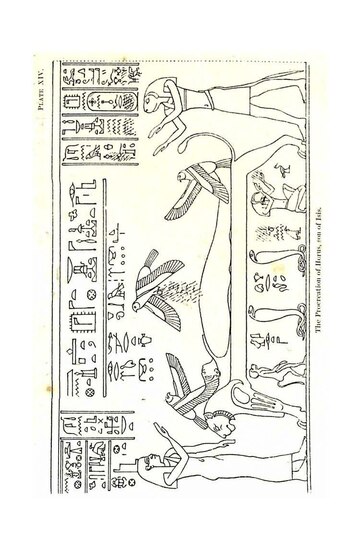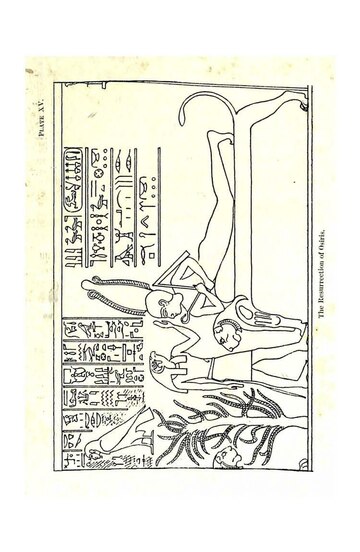Books on Egypt and Chaldaea/Collection 10/Volume 32/Legend of the Birth of Horus, son of Isis and Osiris
V.
Legend of the Birth of Horus, son of Isis and Osiris.
The text which contains this legend is found cut in hieroglyphics upon a stele which is now preserved in Paris. Attention was first called to it by Chabas, who in 1857 gave a translation of it in the Revue Archéologique, p. 65 ff., and pointed out the importance of its contents with his characteristic ability. The hieroglyphic text was first published by Ledrain in his work on the monuments of the Bibliothèque Nationale in Paris,[1] and I gave a transcript of the text, with transliteration and translation, in 1895.[2]
The greater part of the text consists of a hymn to Osiris, which was probably composed under the XVIIIth Dynasty, when an extraordinary development of the cult of that god took place, and when he was placed by Egyptian theologians at the head of all the gods. Though unseen in the temples, his presence filled all Egypt, and his body formed the very substance of the country. He was the God of all gods and the Governor of the Two Companies of the gods, he formed the soul and body of Rā, he was the beneficent Spirit of all spirits, he was himself the celestial food on which the Doubles in the Other World lived. He was the greatest of the gods in On (Heliopolis), Memphis, Herakleopolis, Hermopolis, Abydos, and the region of the First Cataract, and so he embodied in his own person the might of Rā-Tem, Apis and Ptah, the Horus-gods, Thoth and Khnemu, and his rule over Busiris and Abydos continued to be supreme, as it had been for many, many hundreds of years. He was the source of the Nile, the north wind sprang from him, his seats were the stars of heaven which never set, and the imperishable stars were his ministers. All heaven was his dominion, and the doors of the sky opened before him of their own accord when he appeared. He inherited the earth from his father Ḳeb, and the sovereignty of heaven from his mother Nut. In his person he united endless time in the past and endless time in the future. Like Rā he had fought Sebȧ, or Set, the monster of evil, and had defeated him, and his victory assured to him lasting authority over the gods and the dead. He exercised his creative power in making land and water, trees and herbs, cattle and other four-footed beasts, birds of all kinds, and fish and creeping things; even the waste spaces of the desert owed allegiance to him as the creator. And he rolled out the sky, and set the light above the darkness.
The last paragraph of the text contains an allusion to Isis, the sister and wife of Osiris, and mentions the legend of the birth of Horus, which even under the
XVIIIth Dynasty was very ancient. Isis, we are read:[3] “Thy two sisters, Isis and Nephthys, came to thee, Kam-urt, in thy name of Kam-ur, Uatchet-urt in thy name of Uatch-ur”......“Isis and Nephthys weave magical protection for thee in the city of Saut, for thee their lord, in thy name of ‘Lord of Saut,’ for their god, in thy name of ‘God.’ They praise thee; go not thou far from them in thy name of ‘Tua.’ They present offerings to thee; he not wroth in thy name of ‘Tchentru.’ Thy sister Isis cometh to thee rejoicing in her love for thee.[4] Thou hast union with her, thy seed entereth her. She conceiveth in the form of the star Sepṭet (Sothis). Horus-Sepṭ issueth from thee in the form of Horus, dweller in the star Sepṭet. Thou makest a spirit to be in him in his name ‘Spirit dwelling in the god Tchenṭru.’ He avengeth thee in his name of ‘Horus, the son who avenged his father.’ Hail, Osiris, Ḳeb hath brought to thee Horus, he hath avenged thee, he hath brought to thee the hearts of the gods, Horus hath given thee his Eye, thou hast taken possession of the Urert Crown thereby at the head of the gods. Horus hath presented to thee thy members, he hath collected them completely, there is no disorder in thee. Thoth hath seized thy enemy and hath slain him and those who were with him." The above words are addressed to dead kings in the Pyramid Texts, and what the gods were supposed to do for them was believed by the Egyptians to have been actually done for Osiris. These extracts are peculiarly valuable, for they prove that the legend of Osiris which was current under the XVIIIth Dynasty was based upon traditions which were universally accepted in Egypt under the Vth and VIth Dynasties.
The hymn concludes with a reference to the accession of Horus, son of Isis, the flesh and bone of Osiris, to the throne of his grandfather Ḳeb, and to the welcome which he received from the Tchatcha, or Administrators of heaven, and the Company of the Gods, and the Lords of Truth, who assembled in the Great House of Heliopolis to acknowledge his sovereignty. His succession also received the approval of Neb-er-tcher, who, as we saw from the first legend in this book, was the Creator of the Universe.

